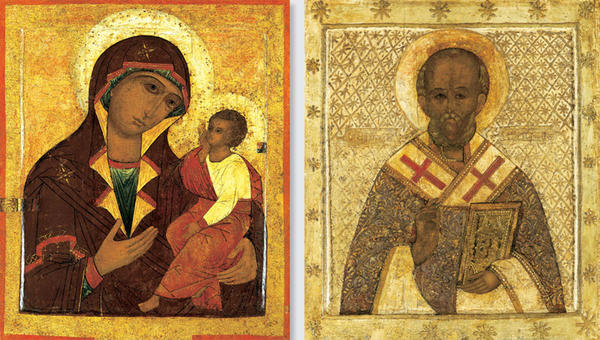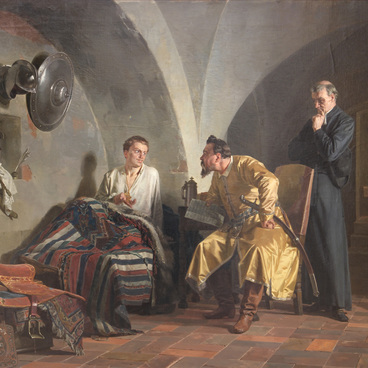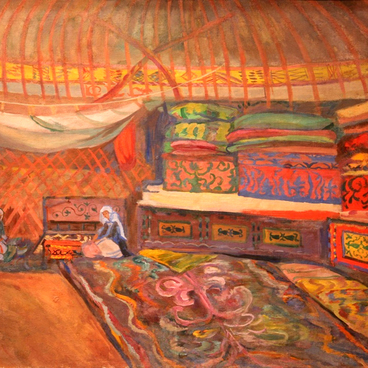An altarpiece icon was usually placed behind the Lord’s table in the sanctuary. The image could be put on the wall, or made of stained glass, or fixed on a staff. In the latter case the icon would be double-sided. One side then would have an icon of Our Lady, usually Hodegeria, or an image of Theotokos with the baby Jesus in her left arm. Translated from Greek, Hodegetria means “showing the way”, “guiding”.
Double-sided altarpiece icon
Creation period
16th-17th centuries
Dimensions
74x40 cm
74х40х3 cm
74х40х3 cm
Technique
Wood, tempera, embossing over primer levkas, carving
Exhibition
2
Open in app#1

Unknown author
Double-sided altarpiece icon
#2
#4
St. Nicholas the Wonderworker
#5
The reverse side of the altarpiece icon usually bears an image of a locally venerated saint. In Russia, it would most often be Saint Nicholas of Myra. St. Nicholas the Wonderworker was the archbishop of the city of Myra in Lycia in the 3rd century AD and became famous for his miracles. He saved innocent people from wrongful execution and resurrected a drowned sailor. Once St. Nicholas saved from dishonour three girls whom their father was planning to turn to whoring to earn money. The wonderworker threw a purse with gold coins through their window, and it fell into a sock that was drying next to the fire. Hence the Christian tradition to hide Christmas gifts in socks over the fireplace, while St. Nicholas of Myra inspired the modern day’s Catholic Santa Claus.
During the persecutions of Christians under the rule of Diocletian, St. Nicholas was thrown into the dungeon and tortured. In the early 300s, Emperor Constantine came to power and gave instructions to set the Wonderworker free. In 325 Nicholas of Myra took part in the First Ecumenical Council, an assembly of clergy that adopted the key Christian dogma, the Trinity. Not all priests had recognized the unity of the Father, the Son and the Holy Ghost before that.
During the persecutions of Christians under the rule of Diocletian, St. Nicholas was thrown into the dungeon and tortured. In the early 300s, Emperor Constantine came to power and gave instructions to set the Wonderworker free. In 325 Nicholas of Myra took part in the First Ecumenical Council, an assembly of clergy that adopted the key Christian dogma, the Trinity. Not all priests had recognized the unity of the Father, the Son and the Holy Ghost before that.
#6
Altar icons
#7
Altar icons can also be processional, used at religious processions, such as during Christmas or Easter. And if a town was attacked by the enemy, an icon like that would be fixed over the fortress’s gate, in the belief that the sacred image was capable of saving the town from destruction.
Processional icons had existed from the very early days, and the earliest known Russian icon dates from the 12th century. The icon from the collection of the State Museum of Fine Arts of Khanty-Mansiysk was painted by Yaroslavl artists in the 16th – 17th centuries.
Processional icons had existed from the very early days, and the earliest known Russian icon dates from the 12th century. The icon from the collection of the State Museum of Fine Arts of Khanty-Mansiysk was painted by Yaroslavl artists in the 16th – 17th centuries.
#8
Iconography
#9
Theotokos is shown in a purple shroud, omophorion, and a blue robe. The purple colour signified the majestic status of the mother of God, and blue stood for purity. With time the colours changed, became darker and yellowish. The icon was painted on a wooden board covered by a linen canvas and levkas, a mixture of chalk, glue and oil.
#10
Saint Nicholas of Myra is shown wearing a priestly dress with the Gospel in his left hand. The saint’s mantle is decorated with ornamental embossing over the levkas; and the background and the frame are decorated with a carved ornament with stars. The researchers believed that the embossed levkas was applied not in the 16th – 17th centuries but later, in the 19th century.
#11
State Museum of Fine Arts of Khanty-Mansiysk
read morehide
00:00
00:00
1x
Double-sided altarpiece icon
Creation period
16th-17th centuries
Dimensions
74x40 cm
74х40х3 cm
74х40х3 cm
Technique
Wood, tempera, embossing over primer levkas, carving
Exhibition
2
Open in app
Share


